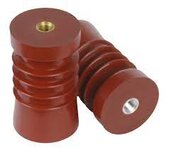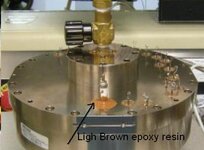agoo
Member level 3
Epoxy resins are used for high voltage power insolators (see attached photo). Anyone can name a few 2-part epoxy resins which are suitable for this purpose? I want to repair a detector and I need to use epoxy resins which can stand high voltage (10 kv) and high tempreature (250 degC).
Detector has Be window which I must change. I want to use epoxy to attache Be window at atmospheric pressure. Then I need to drill a hole at the side of the detector. Put the detector inside the vacuum and do evacuuation down to 10^-6 torr. Then I need to block the drilled hole inside the vacuum using soldering or expoxy resin. Please welcom to comment if you have any suggestion.
thx
Detector has Be window which I must change. I want to use epoxy to attache Be window at atmospheric pressure. Then I need to drill a hole at the side of the detector. Put the detector inside the vacuum and do evacuuation down to 10^-6 torr. Then I need to block the drilled hole inside the vacuum using soldering or expoxy resin. Please welcom to comment if you have any suggestion.
thx

